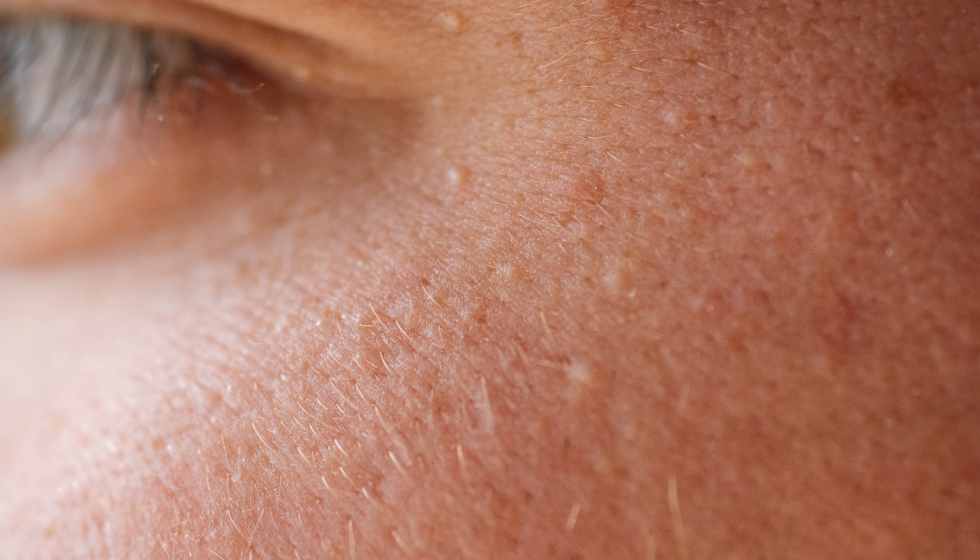Occasionally, any person on the face may appear with small white or yellowish bumps – milia. Unlike pimples, they are quite firm to the touch and do not have redness or inflammation.
What are Milia?
Milia are small, white, or yellowish, spherical papules, one to two millimeters in diameter, located in the superficial layers of the skin. Most often, such pimples appear on the face in especially sensitive areas around the eyes, on the eyelids, or near the nose, less often on other parts of the body.
Histologically, milia are small cysts filled with skin secretions and accumulations of horny masses. Their appearance provokes increased activity of the sebaceous glands and blockage of hair follicles. Millions are single and numerous, united in groups. Congenital and secondary milia are also distinguished.

Congenital milia: Occur at the level of the sebaceous duct and most often occur in newborns. This is because the skin of young children learns to exfoliate dead cells, and the hormonal background is rebuilt. These milia usually go away on their own within a few weeks.
Acquired milia can originate from any epithelial structure, including sebaceous hair follicles and sweat ducts. In most cases, secondary milia result from skin damage, medication, hormonal disorders, genetic abnormalities, and concomitant systemic diseases. They can also resolve spontaneously but with a tendency to relapse.
In both cases, milia do not threaten health. These are benign skin formations that are not prone to rebirth. Unlike acne and other dermatological manifestations, they do not hurt, itch, or become inflamed. But numerous milia, especially on the face, often become a serious aesthetic problem.
A cosmetologist or dermatologist decides it. It is forbidden to squeeze out, pierce with a needle and pick milia on your own, doctors warn. Such manipulations will lead to inflammation, suppuration, scars, and other skin defects in the future.
Causes of milia on the face
Milia appear at any age in people, people of all genders. There are many reasons for this, and not all are fully understood. Milia can be provoked by hormonal failure, problems with the gastrointestinal tract, liver, and pancreas, poor skin care, and bad habits, says Dmitry Urman, dermatocosmetologist and member of the Russian Society of Dermatovenerologists and Cosmetologists.
The most common prerequisites for the appearance of milia include the following.
1. Oily skin
Milia are formed due to excessive secretion of sebum and most often occur in the fattiest areas, where contact with the hands most often occurs and errors in cleansing and care are possible, says Dmitry Urman. According to him, people with oily skin type, adolescents during puberty, and women with elevated levels of androgenic hormones are at risk. Problems with the digestive system can also provoke milia.
“People at risk should control themselves by taking fatty foods and those rich in sugar and gluten. Wet sanitary napkins and thermal water can remove excess sebum and dust for oily skin.
2. Hormonal background
Hormone levels affect every system in the body, and the skin is no exception. The work of the sebaceous glands is subject to androgens. With their increase, sebum is produced in an increased amount, which contributes to the formation of milia.
According to her, one example is polycystic ovary syndrome, characterized by increased testosterone in the blood. Natural aging and fading of ovarian function, accompanied by a decrease in sex hormones, especially estradiol, can negatively affect the skin’s condition in terms of milia formation, the expert adds.
3. Infancy
According to various sources, 40-50% of babies in the first months of life have milia on the face, scalp, and upper body. Some children are born with them; in others, they appear after a while and go away on their own.
“In infants of the first months of life, relative hyperandrogenism is created due to washing out of the mother’s hormones from the blood. This stimulates the sebaceous glands to overproduce sebum and, as a result, the formation of milia and other acne elements occurs,” explains Natalya Lukasheva.
4. Injuries and damage to the skin
At any age, milia can form from a mechanical injury to the skin. Abrasions, prolonged pressure, dermabrasion procedures, and laser resurfacing can provoke them. Other causes of milia include damage from sunburn, radiation therapy, and skin grafts.
Medicine also knows cases when milia occurred on areas of skin with a tattoo. According to experts, their appearance was most likely associated with both mechanical damages to the skin and poor car.
5. Concomitant diseases
Milia can appear with some dermatological defects and genetic diseases. In the first case, according to Dr. Lukasheva, skin diseases with a risk of developing milia include tardive cutaneous porphyria, bullous pemphigoid, epidermolysis bullosa, lupus erythematosus and other conditions accompanied by scarring.
It is also known that milia are associated with certain genodermatosis and can be inherited in an autosomal dominant manner. In particular, such rashes were recorded in Brooke-Spiegler syndrome, congenital pachyonychia type 2, and basal cell nevus syndrome.
6. Medication
Local use of steroids and non-steroidal anti-inflammatory drugs can also provoke milia. In addition, some everyday cosmetics fall into the risk zone. In particular, oil-based products or comedogenic formulations. It is also known that tyrosine kinase inhibitors, which are used to treat various types of oncology, can contribute to the occurrence of milia.
How to remove Milia
In most cases, milia do not require special treatment and leave alone. In the case of numerous periodic rashes, it is not worth expecting them to be compensated by themselves – it is better to consult a doctor, says Dmitry Urman. Dermatologists and cosmetologists remove milia. The specialist selects the method of aesthetic correction individually. Here are some of the cosmetic procedures that help remove milia:
Mechanical cleaning: It is performed with a thin needle or a special spatula when there are several milia of very small diameter on the skin.
Electrocoagulation: During the procedure, milia are removed with a special device that acts on the pimple with a direct or alternating current. This method is also used to remove papillomas, acne, and warts.
Laser removal: In this case, the milia are exposed to a beam of light. The beautician or dermatologist selects the type of laser depending on the number and severity of the rashes. The essence of the procedures is the destruction of the nucleus of the milia with its further removal.
Prevention of the formation of milia
No one is immune from the appearance of milia. However, simple rules in daily skin care will help reduce the risk of rashes. According to experts, here’s what to include in your daily routine:
Cleansing: Make sure you gently cleanse your skin twice daily and use regular makeup that suits your skin type.
Exfoliation: Exfoliate your skin two or three times a week with gentle scrubs and homemade peels to prevent the buildup of dry skin cells that can become trapped in milia.
Nutrition: Use a small amount of retinol to promote healthy cell turnover and minimize the risk of milia.
Sun protection: Sun-damaged skin is at risk for milia. Please choose a quality, lightweight sunscreen with an SPF of 30 or higher and apply it whenever you go outside.


